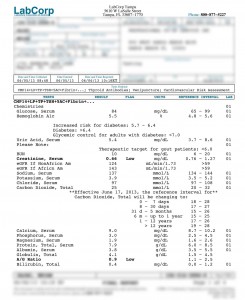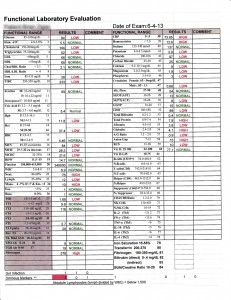A Tale of Two Tests – Traditional Medical VS. Functional Medicine
Before I begin to talk about the results of my tests, I want to explain their overall differences. A medical patient report reports the normal range is the range of levels seen in 95 percent of healthy people in a certain group. For many tests, normal ranges vary depending on your age, gender, race, and other factors. The functional medicine reports challenge what is considered “normal” by giving a smaller range of numbers due to additional factors such as energy levels, healthy digestion, ideal physiological function, etc. Overall the medical tests results are more reactive (you have a problem) while the functional medicine results are proactive (you will and/or are currently having a problem).
My Autoimmune Functional Medicine and Medical Results
Let’s face it, these results are not encouraging. My inflammation levels are off the chart and I have not seen many advancements since my last set of anemia and comprehensive medical results late last year. On the functional medicine side, I have 31 separate markers that are out of range. But what this does tell the doctor is there is a pattern of issues that need to be addressed. Currently they are:
1. Oxidative Stress – Remember that iron I needed for my anemia (test results 11/12)? After the review with my functional medicine doctor, it was determined that my iron levels are more than fine and that I have another type of anemia. If you take a look at the tests, you will see that my Iron Binding (TIBC), Serum Iron, and Saturation are all low along with my HGB & HCT (blood count related). But, my Ferritin level is normal along with my RBC (blood count related). If I was iron-based anemic, my Ferritin level would also be low. While I symptomatically felt better with my iron supplement, my body was getting worse because of the anemia plus too much iron (oxidative stress). In the past I tried getting off of it without supplements and I crashed. Due to the updated supplements I am now receiving, I saw no crash; thus confirming I did not need the iron supplement nor being iron-based anemic.
2. Inflammation – Look for the C-Reactive Protein (CRP) levels and you’ll see they are off the charts high. A normal range is between 0-3 and I am at 73.65. High inflammation hurts today and can lead to heart disease in the future plus it can elevate other markers in all the tests I do. The worst part, though, is that it’s the byproduct of other issues I am going through (i.e. Oxidative Stress), so it makes it very frustrating to see if I am improving and is painfully with me every day of my life until those other issues are found and fixed. Some medical markers to look at are Fibrogen (blood clumping) circulation and Homocysteine (vascular issues that correct absorption of B-Vitamins can help).
3. Malabsorption – no matter how healthy you eat, if your body cannot absorb it, you lose the proper nutrition your body needs. Markers such as lower cholesterol (a precursor to heart disease), low triglycerides, decreased iron binding (TIBC), BUN (protein made in the liver and cleared in the kidneys) and low calcium, magnesium, and phosphorus. A symptomatic sign of this issue is me being underweight and low energy. Animal protein in almost every meal I take seems to stabilize the weight and help regulate the bowels.
4. Bacterial Infections – Many varieties of bacteria are located within our digestive system. When the bad bacteria take over, they cause damage to the lining of the gut and create inflammation. A high percentage of the immune system’s white blood cell Neutrophils and low percentage of lymphocytes are caused by bacterial infections.
5. Low Stomach Acid (Hypochlorhydria) – low levels of stomach acid can allow bad bacteria to colonize in the stomach along with inadequately absorb many nutrients including minerals (iron, copper, zinc and calcium), vitamin B12, folic acid and proteins. Protein levels, albumin, globulin, A/G ratio, and the BUN (protein made in the liver and cleared in the kidneys) irregularities are signs of low stomach acid.
Other issues to examine are B-6 deficiency, hypoglycemia, internal bleeding, free radicals, immune dysfunction, pituitary gland, adrenal disorder, decreased muscle mass, liver dysfunction, and impaired absorption (celiac disease). Most of these issues, however, could be due to the five main issues above. The autoimmune tests I took in early June will be coming in soon and I will reviewing those results in my next blog post.


